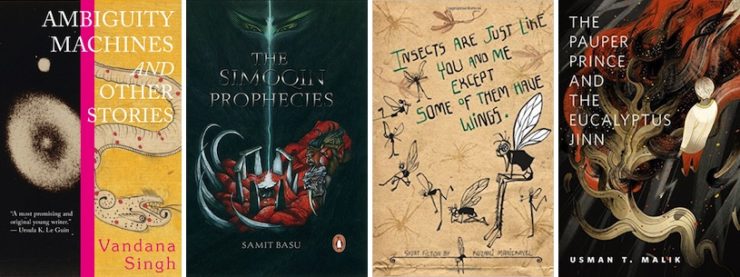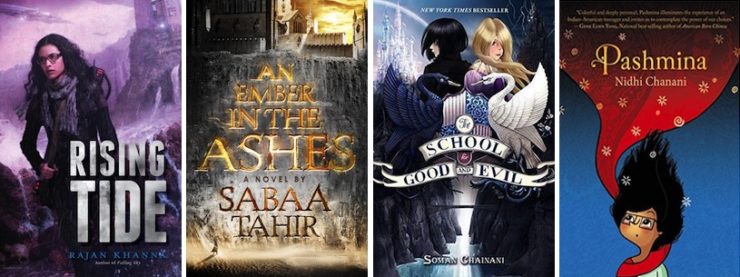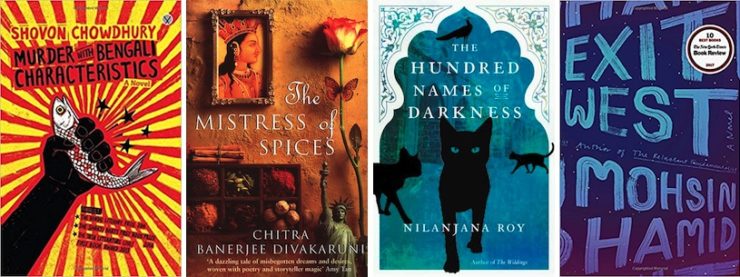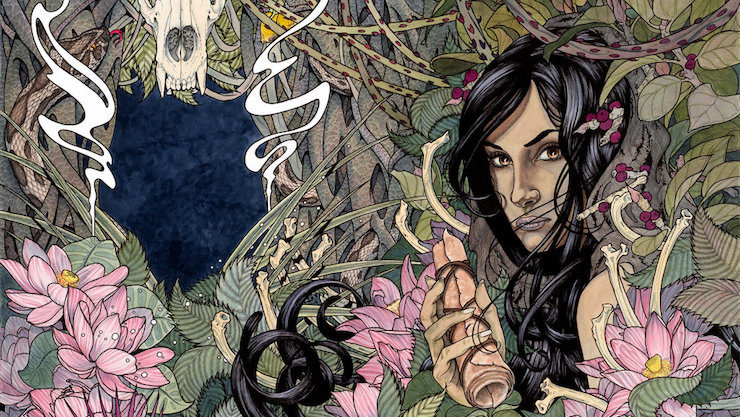Part I of this article, regarding the older traditions of speculative fiction from South Asia, mostly in the regional languages, was published on Tor.com in January 2018.
It was only from the late 1980s that English became the more common language for SFF writers from India. Regional-language traditions still flourish, but the language barriers mean that writers in English receive more visibility both within South Asia and internationally. English-language trade publishing in India also became prominent in the late 1980s, with the entry of Penguin and subsequently the other Big Five international publishers into the market, making it possible for these writers to publish and be distributed widely. This is also the period from which immigrant South Asian writers in English started becoming visible in Western SFF.
South Asian SFF Writers In English—the Homeland
The first distinctly genre fantasy writer in India was Samit Basu, whose Gameworld trilogy was published by Penguin India beginning in 2004, much to the delight of a new generation of SFF fans who read primarily in English, and were only reading SFF by white writers until then. (I was in high school in 2004, and this group included me.) The earliest immigrant Indian writers of SFF from this period are Vandana Singh and Anil Menon. Their short fiction has been published widely in American magazines and anthologies. They also have works published exclusively in India. Speculative fiction in India is also becoming rapidly lucrative, with Netflix recently announcing an original series based on Prayaag Akbar’s novel Leila.
There is still a largely prevalent—but rapidly closing—gap between writers who primarily live and publish in India, like Basu and his successors, and immigrant writers who start publishing short fiction in American magazines, write their first novels much later in their careers, and are not often widely recognized in India, where the English-SFF magazine culture never became very popular.

What to read from this tradition:
- The Calcutta Chromosome (1995) by Amitav Ghosh, the only speculative thriller written by the acclaimed novelist
- The Ramayana series (2003–10) by Ashok K. Banker, an epic fantasy retelling of the Ramayana
- The Gameworld trilogy (2004–07) by Samit Basu, a humorous high-fantasy mash-up set in a South Asian-flavored secondary world, reminiscent of Terry Pratchett and Douglas Adams
- Signal Red (2007) by Rimi B. Chatterjee, a science fiction thriller
- Generation 14 (2008) by Priya Sarukkai Chabria, a science fiction dystopian novel
- Insects Are Just Like You and Me Except Some of Them Have Wings (2008) by Kuzhali Manickavel, innovative short stories that merge the weird-fiction tradition, never quite popular on its own in India, with a Tamil English sensibility
- The Beast With Nine Billion Feet (2009) by Anil Menon, a YA fantasy novel set in India
- The Wordkeepers trilogy (2010–) by Jash Sen, a YA fantasy series based on Hindu mythology
- Red Jihad: Battle for South Asia (2012) by Sami Ahmad Khan, a political/military SF novel set between the near-future India and Pakistan
- The Aryavarta Chronicles trilogy (2012–14) by Krishna Udayasankar, high fantasy set in an alternative Mahabharata-themed world
- Domechild (2012) by Shiv Ramdas, a dystopian science-fiction novel
- The Anantya Tantrist series (2014–) by Shweta Taneja, dark urban/myth fantasy drawing from the Tantrik religious cults, a refreshing break from fantasy based on the mainstream Hindu myths
- “The Pauper Prince and the Eucalyptus Jinn” (2015) by Usman Tanveer Malik, Pakistani horror/fantasy writer who draws heavily from the Urdu tradition
- The Island of Lost Girls (2015) and Escape (2008; published in reverse order) by Manjula Padmanabhan, feminist dystopian novel
- The Devourers (2015) by Indrapramit Das, a haunting historical fantasy that brings together werewolves and obscure South Asian history
- Leila (2017) by Prayaag Akbar, a political novel about a woman’s search for her daughter in a near-future dystopia
- Djinn City (2017) by Saad Z. Hossain, an almost-satirical novel with djinns in modern-day Bangladesh
- Ambiguity Machines and Other Stories (2018) by Vandana Singh, the long-awaited science-fiction short story collection following her 2008 offering, The Woman Who Thought She Was a Planet, and Other Stories
- Mithila Review, the first international SFF zine published from India, edited by Salik Shah, Ajapa Sharma, and Isha Karki
- “Documentary” by Vajra Chandrasekara
- “Rudali” by Amal Singh
- “Jinki and the Paradox” by Sathya Stone
South Asian SFF Writers in English—the Diasporas
This is a separate section because first- and second-generation diasporic South Asian authors, who are writing some incredible fiction right now, are generally unconnected with the older SFF traditions from South Asia. These authors’ readerships often don’t reach homeland South Asia, though they are widely read and appreciated in their home countries. British and American SFF authors of South Asian descent like S. B. Divya, Rajan Khanna, Mary Anne Mohanraj, Priya Sharma, and Sabaa Tahir are popular in the West, but read less often in South Asia. Mohanraj is also one of the founders of Strange Horizons, a major SFF magazine.
Genre boundaries in the current U.S. market place certain authors outside of the main SFF tradition. I recently discovered the works of Nalini Singh and Soman Chainani, both New York Times-bestselling authors with extremely popular series of paranormal romance and young-adult fantasy books, respectively. The characters and plots in their stories are not often South Asian to any specific degree, in terms of the traditions they participate in, but their stories are well-plotted, action-packed and extremely fun to read. Chainani’s School for Good and Evil is almost reminiscent of Hogwarts, and is scheduled to be adapted to film by Universal Studios.
Young Adult fantasy in the U.S. has recently seen a number of bestselling South Asian authors. Indian American authors like Roshani Chokshi, Aditi Khorana, Rati Mehrotra, and Shveta Thakrar locate their fiction in South Asian-flavored secondary worlds—more anachronistic and imaginative than grounded in real-life history—a development specific to this tradition of diasporic writers. The work of graphic novelist Nidhi Chanani is filled with immigrant nostalgia. Pakistani American author Sabaa Tahir writes dark, gruesome fantasy set in an ancient Roman world.
There is also an emerging generation of South Asian SFF writers from the less often centralized diasporas, including Indo-Caribbean writers Ian Muneshwar and Premee Mohamed, and Indo-Chinese Singaporean writer Vina Jie-Min Prasad. While none of these writers have published a full-length book yet, their short fiction is replete with pathbreaking sensibilities, exploring identity and worldview in newer ways that mark a distinct departure from the older generations of South Asian SFF authors.

What to read from this tradition:
- The Psy-Changeling series (2006–) by Nalini Singh
- The Ash Mistry and the Savage Fortress trilogy (2012–13) by Sarwat Chadda
- The School for Good and Evil series (2013–) by Soman Chainani
- The Falling Sky/Ben Gold trilogy (2014–17) by Rajan Khanna
- The Afflictions (2014) by Vikram Paralkar, short stories of medical horror written largely in the tradition of Jorge Luis Borges
- An Ember in the Ashes trilogy (2015–) by Sabaa Tahir
- Pashmina (2016) by Nidhi Chanani
- The Star-Touched Queen (2016) by Roshani Chokshi
- Runtime (2016) by S. B. Divya
- The Library of Fates (2017) Aditi Khorana
- Markswoman (2018) by Rati Mehrotra
- The Serpent’s Secret (2018) by Sayantani Dasgupta
- “Hiranyagarbha” by Kevin Jared Hosein
- “Communion” by Mary Anne Mohanraj
- “And Sneer of Cold Command” by Premee Mohamed
- “Ravana’s Children” by Ian Muneshwar
- “The Padishah Begum’s Reflections” by Shweta Narayan
- “Fandom for Robots” by Vina Jie-Min Prasad
- “Fabulous Beasts” by Priya Sharma
- “A Ghost among the Mangroves” by Naru Dames Sundar
- “The Shadow Collector” by Shveta Thakrar
Magical Realism, Dystopian Satire, and Other Forms Not Strictly SFF
Magical realism is a favorite tradition among South Asian writers in English, with the floodgates having opened after Midnight’s Children by Salman Rushdie won the Man Booker Prize in 1981. Even a couple of decades ago, when Western SFF was still a closed realm for diverse and especially foreign writers, magical realism was a style that emerged out of the mainstream literary tradition, largely developed by the works of writers from postcolonial, non-Anglocentric countries.
Nearly none of the significant magical realists of the day self-identify as SFF writers or locate themselves within the tradition of SFF, and many widely read and award-winning South Asian authors of the last two decades took that route in their careers and storytelling. The Mistress of Spices by Chitra Banerjee Divakaruni was adapted to film by Paul Mayeda Burges in 2005, and Midnight’s Children by Deepa Mehta in 2012.
Dystopian satires, on the other hand, usually take after the works of Huxley, Orwell, Burgess and others, but are distinct from SFF in their concentration on their political subject, rather than focusing on specifically genre elements like worldbuilding or action. These authors are not often mentioned within the SFF tradition, but their works are powerful—politically and historically relevant, linguistically pathbreaking—and currently this strain of South Asian speculative fiction is more active and prolific than more strictly-defined SFF.

What to read from this tradition:
- Midnight’s Children (1981) by Salman Rushdie
- The Mistress of Spices (1997) by Chitra Banerjee Divakaruni
- Red Earth and Pouring Rain (1997) by Vikram Chandra
- The God of Small Things (1997) by Arundhati Roy
- The Age of Shiva (2008) and The City of Devi (2013) by Manil Suri
- The Wildings (2012) and The Hundred Names of Darkness (2013) by Nilanjana Roy
- The Blind Man’s Garden (2013) by Nadeem Aslam
- The Competent Authority and Murder with Bengali Characteristics (2015) by Shovon Chowdhury
- Exit West (2017) by Mohsin Hamid
Mimi Mondal is a Dalit writer and the Poetry and Reprint Editor of Uncanny Magazine. Her first anthology, Luminescent Threads: Connections to Octavia Butler was published in 2017. Her short fiction has been published by PodCastle, Daily Science Fiction, Anathema, Juggernaut Books, and is forthcoming from Fireside and Tor.com. Mimi holds three masters’ degrees for no reason but pure joy. She was formerly a Junior Editor at Penguin Random House India; a Commonwealth Scholar in Publishing Studies at the University of Stirling, Scotland, UK; the Octavia Butler Scholar at Clarion West in 2015; and an Immigrant Artist Fellow at the New York Foundation for the Arts in 2017. She lives in New York, tweets from @Miminality, and always enjoys the company of monsters.










